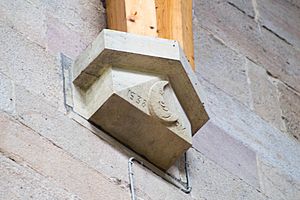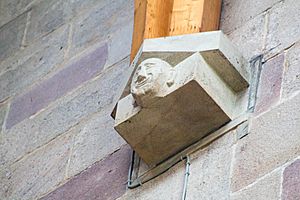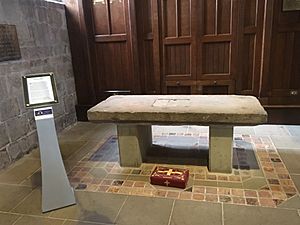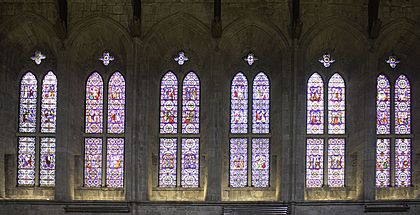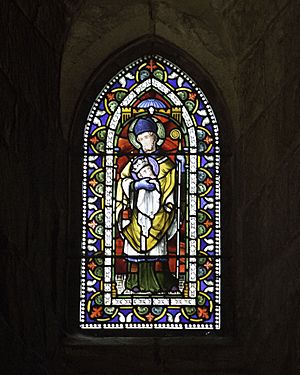Bolton Priory facts for kids
Quick facts for kids Bolton Priory, Bolton Abbey |
|
|---|---|

West Facade of Bolton Priory
|
|
| Lua error in Module:Location_map at line 420: attempt to index field 'wikibase' (a nil value). | |
| Location | Bolton Abbey |
| Country | United Kingdom |
| Denomination | Church of England |
| Churchmanship | Broad Church |
| Website | http://www.boltonpriory.org.uk |
| History | |
| Dedication | St Mary and St Cuthbert |
| Architecture | |
| Heritage designation | Grade I listed building |
| Architectural type | Gothic |
| Administration | |
| Parish | Bolton Abbey (village) |
| Diocese | Anglican Diocese of Leeds |
| Province | York |
Bolton Priory is a very old church in Bolton Abbey (village), North Yorkshire, England. It's officially called The Priory Church of St Mary and St Cuthbert, Bolton Abbey. People have been worshipping here since 1154. That's when a group of Augustinian monks, called canons, moved from a nearby village called Embsay. They started building the church you see today.
Even though most of the Priory buildings were destroyed a long time ago during the Dissolution of the Monasteries, part of the church was saved. This meant local people could keep using it for worship. Today, the Priory is still a busy church. It holds concerts and special talks. Before 2020, over 160,000 visitors came each year!
Contents
History of Bolton Priory
How the Priory Started
The church began as an Augustinian priory in Embsay in 1120. In 1154, the monks moved to Bolton. They started building the church that stands now. The first part of the church was an oblong building. You can still see parts of its walls today. A tower and other sections were added around it. A cloister (a covered walkway) was built to the south.
The main part of the church, called the nave, was finished in the mid-1200s. The church was completed with a beautiful west front, which is still standing.
Changes in the 1300s
The monks made big improvements in the 1300s. The chancel (the area around the altar) was made longer. The choir moved to a new spot. A rood screen (a screen separating the nave from the chancel) was also moved. A north aisle was built, and its windows were decorated. The chancel was made taller, and fancy windows were added.
Many of these old windows have been damaged over time. The transepts (the arms of the cross-shaped church) were mostly rebuilt. A new, eight-sided chapter house was built. The Prior (the head of the priory) also moved his living area. Most of these old buildings are now ruins. You can only see the bases of their walls.
The Unfinished Tower
In 1520, Prior Moone, who was the last Prior, began building the West Tower. He planned for it to be three times taller than it is now. It was built on its own foundations. The idea was to connect it to the main church later. Work was slow, maybe because the church roof needed fixing. Only about a third of the tower was built before work stopped. This happened because of the Dissolution of the Monasteries.
The tower was left without a roof or glass in its windows. But it protected the west wall of the church. This wall is considered a very beautiful piece of 13th-century art. The tower itself was a great design. If it had been finished, it would have been one of the best in England.
Above the West Tower doorway, there's an old inscription. It has Prior Moone's symbol (a moon). It says he "began this foundacyon in MCVXX" (1520). There are also models of dogs. These might be a clue to the Prior's job as a forester. One dog with an open mouth is linked to the "Hey Diddle Diddle" rhyme. On the other side, there's a statue of a pilgrim. This might be William de Forz, who may have paid for the church's nave.
The Priory Closes Down
The Priory was closed down in 1539. Because it was an Augustinian priory, the monks also served as priests for local churches. So, it was like the local church for the area. This is why the western half of the church was saved. A simple stone wall was built to separate it from the eastern half, which soon became a ruin.
The Priory's valuable items went to the King. The lead from the roof and the bells went to Thomas Cromwell. Many buildings fell apart or were taken down. Their stones were used for other buildings nearby. Prior Moone and the other monks were given pensions.
For the next 200 years, the church was looked after by a curate. Not much is known about this time. In 1728, Richard Boyle started to restore the church. He added new floors and doors. He also whitewashed the inside and fixed the windows. In 1796, the layout of the church was changed. The pews were turned to face a pulpit, not the altar.
Restoration in the 1800s
In the mid-1800s, people wanted to bring back the "medieval" church style. In 1854, William Cavendish asked Augustus Pugin to design new stained-glass windows. Pugin was famous for his work on the Houses of Parliament. Then, in 1866, a big restoration project began. It was led by George Street.
The church was changed back to face the altar. This showed the importance of the Eucharist (Holy Communion). A low wall was built around the altar area. This was like a design from a church in Rome. The old wall from the Dissolution was removed. A new wall was put in its place. It was decorated with paintings of plants and religious symbols by George Bottomley.
The plaster and whitewash were taken off the walls. The chancel floor was tiled. New oak pews were installed, and a new font was added. A new organ was also ordered.
The 1900s and 2000s
Worship continued, but by the late 1900s, the church was in bad shape. The number of people attending services was very small. The church was almost abandoned. But Canon Maurice Slaughter helped bring it back to life. He raised money and oversaw a big repair project in the 1980s.
The organ was updated. A stone altar that had been hidden was put back. The bell tower was replaced, and the old bell was re-hung. The windows in the west tower were finally given glass, after 450 years! The tower also got a roof. The roof supports have symbols of Prior Moone and Canon Slaughter. Canon Slaughter's ashes are buried near the north wall.
In 1950, electric lights were installed. In 2016, these were replaced with modern LED lights. These new lights are hidden and can be controlled remotely. They make the church look beautiful and are great for services and concerts.
In the 21st century, the church faced new challenges. In 2019, Bolton Priory switched from fossil fuels to electric heating from renewable energy. Then, the COVID-19 pandemic hit in 2020. The church closed for a long time. During this time, they started online services. After the pandemic, Wi-Fi was added. This allows services to be streamed around the world. People from far away places like South Africa and South America have joined online. The church also added digital ways to collect donations.
Important People Connected to the Priory
The families who supported Bolton Priory were often important in national affairs. The first family, the Albemarles, were patrons from 1120 to 1293. One important person was Hawise. Her second husband, William de Forz, is thought to be the pilgrim statue outside the West Tower.
Later, in 1310, the Crown gave the estate to Robert de Clifford. The Cliffords owned the Priory for 229 years. They lived through many wars.
In 1492, the Clifford family became the Earls of Cumberland. They held the estate for 134 years. George, the third Earl, had an interesting life. He fought against the Spanish Armada. But he was not good at managing his estate. His wife, Margaret, studied alchemy with John Dee, a famous magician.
The third Earl gave the estate to his brother, not his daughter, Lady Anne Clifford. This caused a long legal fight. Anne eventually won and got back much of her family's land. But the Bolton estate went to another family, the Burlingtons.
The Burlingtons owned the estate from 1643 for 77 years. During this time, a grammar school was founded. It was paid for by Robert Boyle, a famous physicist. The school was built with stones from the ruined Priory.
After 1753, the estate passed to the present owners, the Dukes of Devonshire.
One important minister was William Carr (1789–1843). He was also a headmaster and a farmer. He even bred a very famous large cow! His grave is in the church.
Canon Maurice Slaughter was also very important. He left a busy church to come to the almost empty Priory. He worked hard to revive and rebuild the church. He finally added the roof to the incomplete tower.
Location of Bolton Priory
The Priory church is made from the nave and west tower of the old Augustinian priory. It sits on a slope above the River Wharfe, near Bolton Abbey village. Next to it are the ruins of the old chancel, crossing, and transept. You can also see the foundations of the chapter house and cloister.
To the west of the church is a 14th-century gatehouse. It has been turned into a hall. Behind it is an aqueduct built in the 1700s. It carried water to the mills. To the south is the Boyle School, now the rectory. It was built on the site of the old kitchens and guest house. You can still see the guest house chimney. There are also old fish-ponds nearby. A tithe barn is also on the site, but it has been rebuilt many times.
Inside the Priory
There are two crypts (underground rooms) in the church. One is still complete. The second one, now under the organ, used to hold coffins. It was later filled with bones found during the 1866 restoration.
A stone altar in the north aisle was saved during the Dissolution. It was used to cover one of the crypts. Later, it was moved into the church. In the 1980s, it was finally set up properly. It's surrounded by medieval tiles found in the ruins. A hollow in the middle suggests it might have once held a relic (a holy object).
You can see original piscinas (basins for washing communion vessels) at the east ends of both the north and south walls. There's also an original stone bench on the south wall.
The capitals (tops of pillars) on the south-east door copy 12th-century designs. The font was designed by George Street and installed in 1867.
An alcove (a small recessed area) in the south wall is quite unique. It was built when the north wall was made wider. A narrow staircase leads up to it. No one is quite sure what its original purpose was.
The lower parts of the north aisle windows have Victorian stained glass. But their upper parts have older, 14th-century colored glass. They show a king and a queen.
The Pugin Windows are some of the last designed by Augustus Pugin. They are also among the best attempts to copy early medieval stained glass.
A Painted Wall is behind the altar. It shows plants and symbols from the Bible. You can find the artist's signature and other hidden symbols in the design. This wall was once hidden behind a curtain because not everyone liked it. But during restoration work in the 1980s, it was rediscovered in perfect condition.
For special occasions, the Priory uses a chalice (a cup for communion) given by Lady Anne Clifford, 14th Baroness de Clifford. It was made in York in 1656.
The church has two pieces of furniture made by Robert Thompson, known as the 'Mouseman'. He carved a tiny mouse into each piece. One is the Bishop's Chair, and the other is a board listing past Priors and Rectors.
The Priory is dedicated to St Cuthbert and the Virgin Mary. St Cuthbert is remembered with a window at the west end of the north aisle. On September 7, 2014, a statue of the Virgin Mary was dedicated. It was carved by Tim Foster from York Minster.
The Churchyard
The sloping ground north and east of the church is the graveyard. It goes down towards the River Wharfe. The views from the Priory and of the Priory have always attracted artists. Famous ones include Turner and Wordsworth.
Prior Moone's grave is in the crossing. There is also a memorial to Lord Frederick Cavendish, who died in Phoenix Park, Dublin. It was given by workers from the Bolton Abbey estate. Just north of the church, he is also remembered by a fountain.
A famous story linked to the churchyard is about The White Doe of Rylstone. Richard Norton and eight of his sons joined a rebellion. They were captured and executed. His youngest son, Francis, escaped but was later killed. He was buried on the north side of the Priory. The story says his sister Emily visited his grave with a white doe he had given her. The doe continued to visit the graveyard during Sunday services. It was seen as very special.
The graveyard also holds the remains of a WWI soldier, Lt Smeeth. Other notable people buried here include author Gillian Baverstock (daughter of Enid Blyton), and famous cricketers Bob Appleyard and Fred Trueman.
Other Burials in the Priory
Special Events
The Priory hosts many events. Some groups put on concerts for paying audiences. Other groups hold "open rehearsals" when visitors are around. The Priory also manages its own events.
The St Cuthbert Lecture
This lecture happens every year in February or March. It covers topics about society, religion, or history. Past speakers include bishops, archaeologists, and journalists.
Priory Concert Series
This is a series of four concerts held each summer. Groups like the Leeds Philharmonic Society and the Manchester Chorale have performed here.


